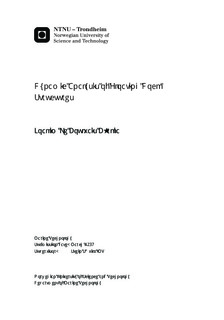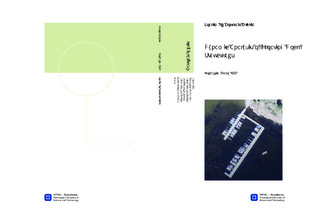| dc.contributor.advisor | Sævik, Svein | |
| dc.contributor.author | Børkja, Joakim Le Boulvais | |
| dc.date.accessioned | 2015-10-05T15:03:21Z | |
| dc.date.available | 2015-10-05T15:03:21Z | |
| dc.date.created | 2015-03-25 | |
| dc.date.issued | 2015 | |
| dc.identifier | ntnudaim:12564 | |
| dc.identifier.uri | http://hdl.handle.net/11250/2350631 | |
| dc.description.abstract | This paper concerns a dynamic analysis preformed on a floating dock structure. The structure was installed by Bi-Brygga AS and failed in 2013 during a winter storm. Bi-Brygga AS offered this structure as a case study for a Master's thesis. There are currently no regulations detailing the design of floating docks. The case study was to be done in part to establish a basis on which future regulations could be based. This was to be achieved by studying standards for similar structures such as fish farms. The program SIMA was to be used to model the floating dock structure.
In the paper, a literature study was done in order to establish the necessary parameters required to perform a dynamic analysis on the floating dock model in SIMA. All assumptions and simplifications made were presented along side the determined analysis parameters. Then the model was subjected to a 50 year design storm and to the 2013 winter storm. The peak forces of 30 different design storms were Gumbel distributed and the 90 percentile values were chosen as design values. The results revealed that the floating dock structure was severely under-dimensioned. In order to survive the 50 year design storm the mooring lines would have to have their capacity increased threefold from 30 tons to 90 tons. Several lines also suffered failure when subjected to the 2013 winter storm, which corresponds to reality. The 90 percentile values may however be overestimating the actual loads somewhat.
The floating dock model was also subjected to varying environmental conditions. It was determined that the current forces were negligible in this case. Different wave spectra were considered and it was found that they yield nearly identical responses. This was likely due to a inadequately chosen parameter in the time domain simulation. The shallow water spectrum was considered to be the most accurate based on theory. The effect of mooring line tautness was also investigated. It was found that slack in the mooring line significantly increases the mooring line peak tension. This increase was caused by snapping.
The design wave method was evaluated as a possible simplified wave model. However, it was found lacking as it could not accurately account for the dynamic effects acting on the floating structure, because it underestimated the total forces. It was concluded that the simplest method for accurately calculating the loads on a floating docks structure is the dynamic model presented in this paper. | |
| dc.language | eng | |
| dc.publisher | NTNU | |
| dc.subject | Marin teknikk, Marin konstruksjonsteknikk | |
| dc.title | Dynamic Analysis of Floating Dock Structures | |
| dc.type | Master thesis | |
| dc.source.pagenumber | 150 | |

